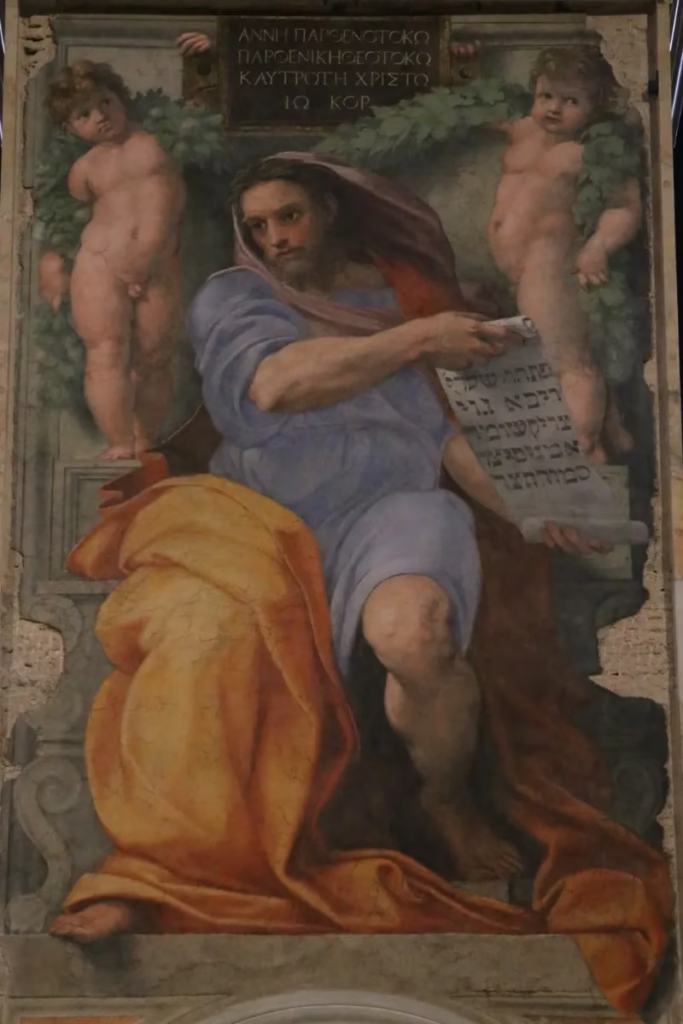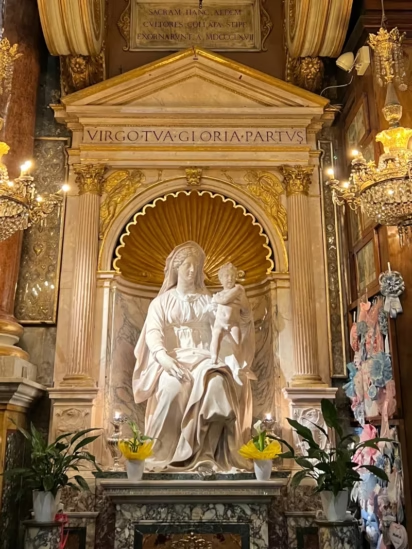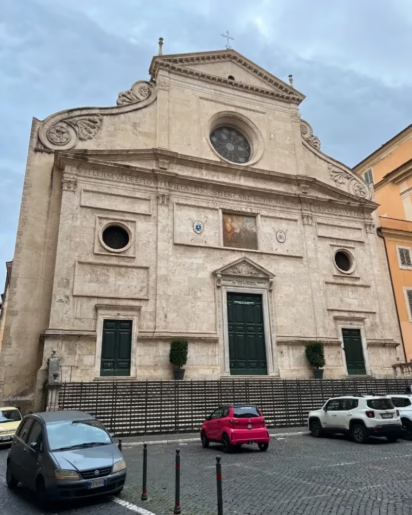Visit Sant’Agostino to see art by Caravaggio, Raphael, Guercino, and the Sansovinos for free in a Renaissance church near the Pantheon in Rome.

Paintings by Caravaggio and Raphael in Sant’Agostino are for most tourists the main reason to visit this small church in Rome. However, this typical small Renaissance basilica has many further artworks including fine paintings by Guercino and sculptures by the Sansovinos. Although in central Rome, it is often quiet and easy to stroll in for a quick visit.
See Art in Sant’Agostino Church in Rome
The current Basilica of St Augustine in Campo Marzio (Basilica di Sant’Agostino) is a fine example of Roman Renaissance church architecture but it is mostly visited by tourists to see the art and by locals to pray for uncomplicated delivery in childbirth. The church is somewhat hidden not far from the Pantheon (which is no longer free!), San Luigi dei Francesi, and the Palazzo Altemps.
The floor plan of Sant’Agostino follows a fairly typical basilica layout of a triple nave with the side aisles noticeably narrow and enhanced with further side chapels. The church and typical Renaissance facade were constructed in the late 15th century.
Traditionally, the church was popular with courtesans who used masses not only to pray but to show off and advertise. Fiammetta, the lover of Cesare Borgia, even bought her own chapel here — now the Cappella Cavalletti where Caravaggio’s Madonna is on display.
Caravaggio and Raphael’s Paintings in Sant’Agostino
For most tourists, the main attractions for visiting Sant’Agostino are to see a painting by Caravaggio and a Michelangelo-inspired fresco by Raphael. Both works are accompanied by stories and gossip to complement the high quality of the art.
Pilgrim’s Madonna by Caravaggio in Sant’Agostino
Caravaggio’s Madonna of Loreto, also Pilgrim’s Madonna (Madonna dei Pellegrini), was painted 1604-1606, and immediately caused a scandal. For once, it was not the nudity or the licentious looks, but rather the poor surroundings and lack of respectable holiness.
Caravaggio painted the Virgin Mary as a fairly ordinary mother, if rather beautiful, with a child in her arms looking somewhat bored, maybe even slightly annoyed. Although she has a slim halo and wears fine garments, she is barefoot. As are the pilgrims who are rather shabbily dressed and with dirty feet and clothes. This was not the noble and educated Mary popular in Roman Catholic art since at least the Middle Ages.
According to Giovanni Baglione, a competitor of Caravaggio, people were laughing and sniggering when the painting was unveiled and the patron was rather upset. The Augustine monks were shocked and the sponsoring family refused to pay.
The Lady of Loreto refers to the Holy House that is located in the city of Loreto on the Adriatic Coast. According to tradition, this was the house in which Mary was born, where she received the annunciation, and where Jesus spent his childhood years. It was miraculously transported by angels from Nazareth to Loreto — it became a popular pilgrimage destination since the 14th century.
The painting thus shows the Virgin on her own doorstep, which is far from the elegant and marble-enclosed Casa Santa in the pilgrimage church in Loreto (Santuario Basilica Pontificia della Santa Casa di Loreto).
Furthermore, Caravaggio used as a model probably the same woman (Lena) he painted in The Madonna and Child with St Anne, now in the Borghese Gallery. She was also accused of being a prostitute, which fitted in rather well with the history of a previous owner of this chapel but less so with the image the church wanted to convey.
Caravaggio’s Madonna of Loreto is in the Chapel of Cavalletti or the Cappella della Madonna di Loreto — at the back of the church, left. The adjacent frescoes are by Cristoforo Casolani (early 17th century): St William of Malavalle on the right and Mary Magdalene on the left, and in the semi-dome the annunciation, the coronation of Maria, and the birth of Christ.
See also: Where to See Caravaggio Paintings in Rome
The Prophet Isaiah Fresco by Raphael in Sant’Agostino
The fresco of The Prophet Isaiah by Raphael was commissioned by Johann van Goritz (Janus Corycius) for his planned tomb in the aisle of Sant’Agostino — second left pillar from the back. Isaiah, flanked by two naked cherubs, holds a scroll inscribed in Hebrew with the words of Isaiah 16:2-3: “Open the gates that the righteous nation may enter, the nation that keeps faith.”
Raphael was almost certainly inspired by the work of Michelangelo but the artistic influences probably flowed both ways. A story goes that Goritz complained to Michelangelo that he was overcharged by Raphael to which Michelangelo commented that Isaiah’s bare knee alone was cheap at the price.
Sculptures by the Sansovinos in Sant’Agostino
The two most famous sculptures in Sant’Agostino are by two artists named Sansovino:
The Madonna and Child with St. Anne (1512) by Andrea Sansovino (c. 1467-1529) is directly below Raphael’s fresco and was part of the original design for the tomb of Goritz. According to non-standard biblical sources, St Anne was the mother of Mary and the positioning of the sculpture follows the line from the prediction by Isaiah of the coming of a Savior to the actual birth of Christ. In their faces, Andrea Sansovino skilfully showed the contrast in the ages between Jesus’s mother and grandmother. In contrast to many other similar works, the eye contact is between Jesus and Anne.
The Madonna del Parto (Our Lady of Childbirth, 1521) is by Jacopo Sansovino (1486-1579). He was a student of Andrea and adopted the name Sansovino in place of his own (Tatti). He is most famous for his work at San Marco in Venice but in Rome, his Madonna is particularly loved. It is positioned right at the back of the church next to the main door and is impossible to miss.
Sansovino’s Madonna del Parto was originally just another madonna in another family chapel. However, by the mid-17th century, rumors spread that the grouping was actually Giulia Agrippina with her son Nero. Real fame and popularity had to wait until the 19th century when the sculpture became an object of adoration and was considered to be helpful in safe childbirth — something encouraged by the inscription above the statue: Virgin Your Glory is Giving Birth. In 1822, Pope Pius VII announced a 200-day indulgence for anyone kissing her foot. The marble was subsequently kissed away and she now sports a silver foot. The Madonna is still constantly surrounded by cards and votive offerings.
Further Art in Sant’Agostino in Rome
Like so many other small Renaissance churches in central Rome, Sant’Agostino is filled with further art. The general condition of the church is very good and many of the paintings are bright and well lit.
Several of the frescos in the nave and ceiling paintings are by Pietro Gagliardi — painted in the 1860s during restoration work.
However, most of the art in the church is from the Renaissance and Baroque periods. The frescoes of St. John the Baptist and St. John the Evangelist are by Avanzino Nucci (1588) while Guercino painted Saints Augustine, John the Evangelist, and Jerome in the Buongiovanni Chapel (1600s).
The design of the high altar is often attributed to Lorenzo Bernini but most current thinking gives Orazio Turriani the honor.
How to See Caravaggio and Raphael’s Paintings in Sant’Agostino
The Caravaggio, Raphael, and other art in Sant’Agostino may be enjoyed for free during the regular opening hours of the church. Like most churches in Rome, the church is open daily with a lunch break.
Currently, the opening hours are daily from 7:30 to 12:00 and 16:00 to 18:30. Times change frequently but usually not by much — exact hours are posted on the gate. Tourist visits on Sundays are often difficult due to frequent masses.
The Basilica of Sant’Agostino is on the similarly named Piazza in central Rome but often slightly off the main tourist routes. It is behind the McDonald’s near the north end of Piazza Navona and close to the Palazzo Altemps and San Luigi dei Francesi (with three of the Caravaggios of around 20 on public display in Rome). The Pantheon, which is no longer free, is also just a few blocks away.







